How To Switch Cameras On Galaxy S10
Please notation: In September 2019, we updated the DXOMARK Mobile exam protocol to encompassultra-broad-angle performance and take renamed the protocolDXOMARK Photographic camera. We too expanded our low-light testing and created the newNighttime sub-score, which incorporates the previous Flash score. We have retested this device using the new Wide and Dark exam protocols and updated this review. The updated elements and scores are right at the tiptop; you can even so find the original review further downwards the page. For more than information, delight encounter the articles about our new Wide and Nighttime test protocols.
The Milky way S10 5G is the ultra-premium version of Samsung'due south flagship S10 family unit of smartphones, and apart from 5G connectivity, comes with 8GB of RAM and a 6.7-inch, HDR10+ -certified AMOLED display. The master camera organization combines a chief 12Mp camera and variable-aperture lens with a 16Mp ultra-broad-angle module and a 12Mp 2x telephoto module. Compared to the standard S10 model, the 5G model likewise adds a Fourth dimension-of-Flight (TOF) sensor to assist with bokeh when shooting video too as with augmented reality applications.
Update summary

116

camera
Cheers to excellent results in both our new broad-angle and low-light tests, the Galaxy S10 5G maintains its position very close to the elevation of the DXOMARK Camera ranking. The Samsung offers one of the widest fields of view of all devices on the market, and despite the optical challenges that come with that, it still manages to maintain decent image quality across all wide-bending focal lengths. Levels of detail are low compared to the competition, and at that place is strong softness in the corners, but outdoor images prove good exposure, nice colors, and a fairly wide dynamic range. Noise is visible across all light weather condition, particularly in depression light, simply compared to nigh competitors, it is pretty well-managed.
The S10 5G is also ane of the best performers in the new Nighttime category, with generally adept results at all flash settings. Simply when shooting with the wink switched off in very low light tin can images exist underexposed. (The firmware version we used for our testing does not offer a Nighttime mode, and then the S10 5G could not earn any bonus points for this feature.)
The Galaxy S10 5G is also notwithstanding i of the best devices in our database in almost other areas. It cannot keep upwards with the Huawei P30 Pro's impressive zoom functioning, but delivers excellent still image results in near whatsoever other aspect and is outstanding for video likewise. Video footage all the same shows the same excellent target exposure and color as on the S10+, and the 4K resolution at default settings helps amend texture, dissonance, and artifact scores. Overall, the S10 5G is still a great selection for mobile photographers and videographers alike.

Wide
Samsung Galaxy S10 5G (Exynos)
40
When switching to its broad-bending camera, the Samsung Galaxy S10 5G offers a very wide equivalent focal length of 12mm and is capable of maintaining expert image quality across all wide focal lengths in indoor and outdoor conditions, earning itself i of the electric current best Broad scores. In the comparing below, you lot can see that at the widest zoom setting the Samsung offers a considerably wider field of view than the Huawei P30 Pro and the Xiaomi Mi 9.

Samsung Galaxy S10 5G, minimum focal length
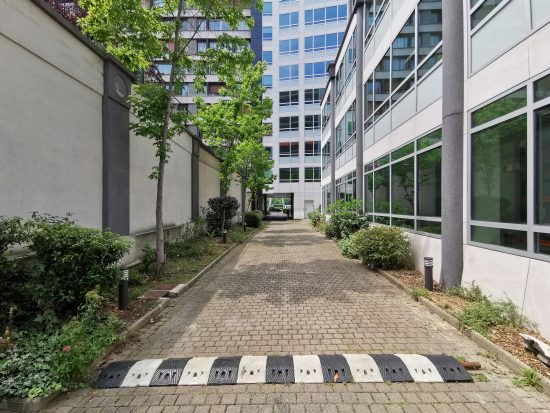
Huawei P30 Pro, minimum focal length

Xiaomi Mi 9, minimum focal length
Exposure is mostly accurate in outdoor conditions, with only some slight instabilities at wider settings. Color rendering is generally stable and pleasant, although some outdoor images can show a slight blue cast. Dynamic range is good, allowing for decent shadow and highlight detail in high-contrast scenes, but we also saw some haloing along loftier-contrast edges in those conditions. While some racket is visible in all light conditions, specially indoors and in low light, it tends to be adequately well-controlled in comparison to the competition.
On the downside, the level of detail that the S10 5G wide-angle camera captures is lower than for most direct competitors, even in bright lite. In the comparison images beneath, yous tin can see that the S10 5G doesn't return fine item and textures quite likewise as the Huawei P30 Pro at wide-angle settings.

Samsung Galaxy S10 5G, detail rendering

Samsung Galaxy S10 5G, crop
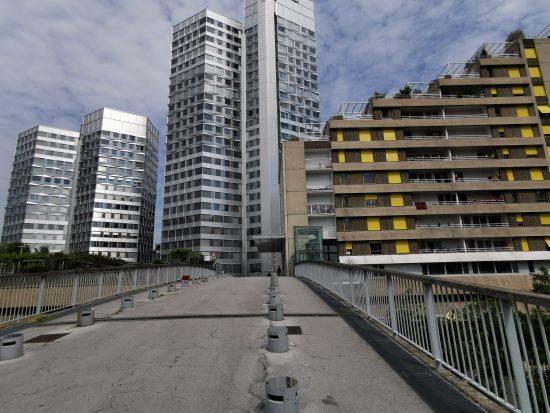
Huawei P30 Pro, detail rendering

Various artifacts also elevate downward the Samsung's Wide score, but go less intrusive as you movement from the widest available focal lengths to less farthermost settings. A lack of sharpness in the corners and distortion are very noticeable at the widest settings, only considering that the Samsung offers a wider angle of view than almost rivals, the paradigm quality is nevertheless acceptable.
Our testers too found some anamorphosis (deformation of faces close to the edges of the frame), haloing, and color fringing in the S10 5G's sample images, and ringing is often visible when shooting under indoor lighting. Despite these imperfections, the Samsung Milky way S10 5G is currently one of the all-time performers for wide-angle shooting overall. However, there is still quite some room for improvement and nosotros can expect hereafter device generations to increase wide-angle image quality considerably.
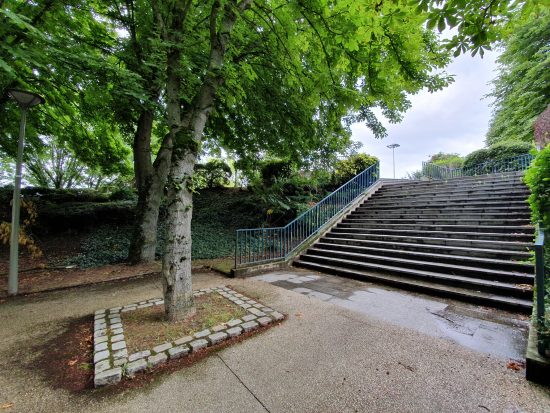
Samsung Milky way S10 5G, color fringing and softness

Samsung Galaxy S10 5G, crop, color fringing and softness

Samsung Galaxy S10 5G, strong ringing indoors

Samsung Milky way S10 5G, crop, strong ringing indoors

Night
Samsung Galaxy S10 5G (Exynos)
59
The Samsung Galaxy S10 5G achieves one of the highest Night sub-scores and so far, merely as with virtually any other smartphone, there is however quite a lot of room for improvement when shooting in depression light.
At its default setting, the Samsung'due south flash-machine performance is excellent. The flash ever triggers when information technology detects a face in the frame, and the resulting images evidence adept target exposure, fairly accurate white balance, and good levels of detail. The flash also occasionally triggers when capturing a landscape or cityscape scene—which isn't particularly ideal—simply prototype quality is commonly still decent even on those occasions.

Samsung Galaxy S10 5G, wink auto
![]()
Google Pixel three, flash motorcar

With the wink switched off, target exposure in cityscapes and dynamic range are pretty good, resulting in quite pleasing night shots overall. When viewing images at full size, it becomes obvious that the levels of particular are pretty depression compared to the competition, but image racket is fairly well under control.
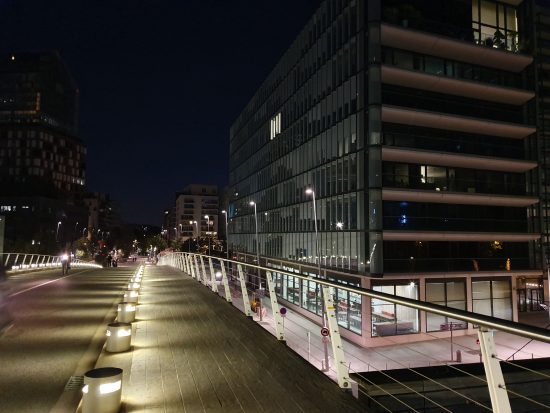
Samsung Milky way S10 5G, flash off

Samsung Milky way S10 5G, crop
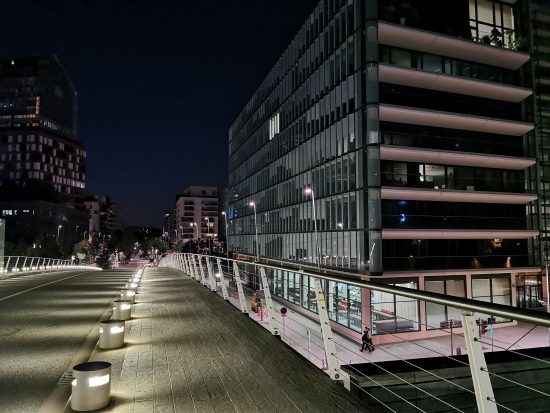
Huawei P30 Pro, flash off

Images are severely underexposed in very low light. In the comparing beneath, you tin can meet that the Huawei P30 Pro manages to get a noticeably brighter exposure than the S10 5G out of this extremely nighttime test scene. This said, the Xiaomi image is even darker than the Samsung'due south.
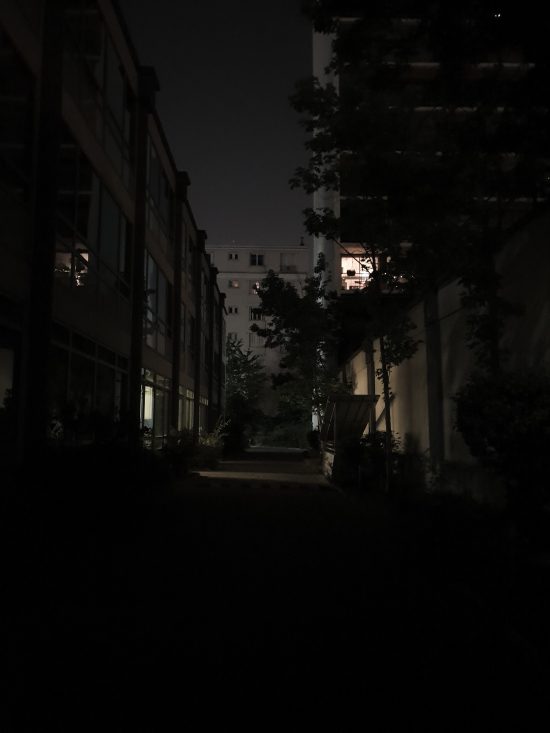
Samsung Galaxy S10 5G, flash off
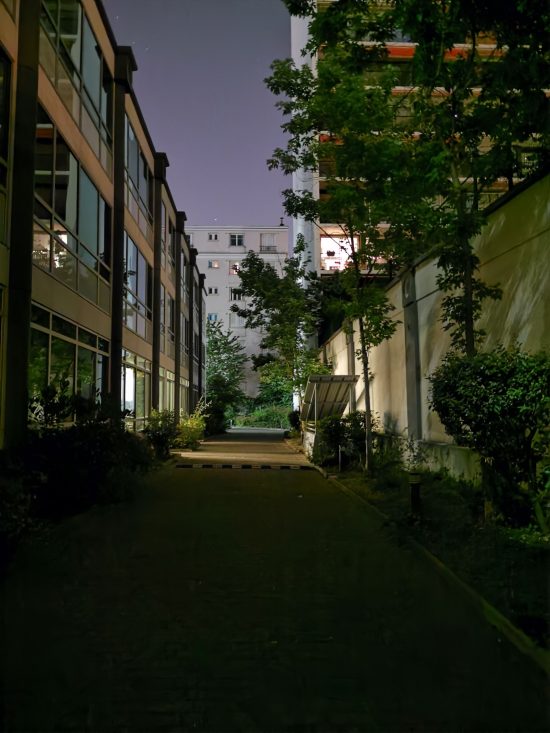
Huawei P30 Pro, flash off
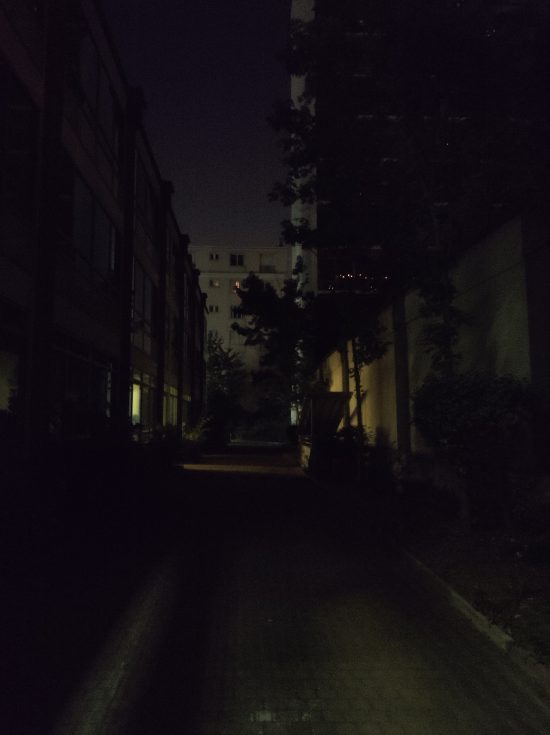
When shooting nether typical urban sodium vapor street lighting, the white residuum system tends to produce a yellow cast that is quite noticeable, but within adequate limits.
With the wink forced on, the Galaxy S10 5G improves on the already excellent operation of the S10+. Like the S10+, wink photography with the S10 5G features authentic exposures, neutral white rest, and good particular preservation. Samsung has lessened the light falloff compared to the S10+, providing more pleasing images both when using wink only and when combining flash with ambience light. However, red-eye artifacts can be visible.
Please note: With its latest firmware version, the Samsung Galaxy S10 5G comes with a defended night mode. However, we undertook the Night testing for this updated review using the same firmware version as the original examination, which did not include a nighttime style.
Samsung Galaxy S10 5G photographic camera review (originally published April 16, 2019)
The Galaxy S10 5G is the new, ultra-premium version of Samsung'south flagship S10 family of smartphones. Information technology comes with 8GB of RAM, along with a 6.vii-inch, 3040×1440 pixel, HDR10+ -certified AMOLED display. It's loaded with either 256GB or 512GB of memory, which is helpful, since there is no microSD slot. The main camera organization combines a primary 12Mp photographic camera and variable-aperture lens with a 16Mp ultra-broad-angle module and a 12Mp 2x telephoto module. Compared to the standard S10 model, the 5G model also adds a Fourth dimension of Flight (TOF) sensor to assist with bokeh when shooting video too equally with augmented reality applications. Read our review to find out how the Korean manufacturer's new high-end version of its S10 flagship phone performed in our DxOMark Mobile testing.
Primal camera specifications:
- Quad-camera setup, including a dedicated TOF sensor
- Primary: 12Mp sensor with 1.4µm pixels and 26mm-equivalent, f/1.five–2.four aperture lens, dual-pixel AF, OIS
- Ultra-wide: 16Mp sensor ane.0µm pixels and 13mm-equivalent, f/2.2-aperture lens
- Telephoto: 12Mp sensor with 1.0µm pixels and 52mm-equivalent, f/2.4 discontinuity lens, PDAF, OIS
- 2160p/60fps, shoots 4K video at 30fps by default
Please note: The photographic camera firmware used for the DxOMark tests is non yet currently available to consumers. Samsung will make information technology available as an over-the-air update before the end of the calendar month.
About DxOMark Mobile tests: For scoring and analysis in our smartphone camera reviews, DxOMark engineers capture and evaluate over 1500 test images and more ii hours of video both in controlled lab environments and in natural indoor and outdoor scenes, using the camera's default settings. This commodity is designed to highlight the most important results of our testing. For more than data nearly the DxOMark Mobile test protocol, click here. More than details on how we score smartphone cameras are available hither.
Examination summary
Its overall DxOMark Mobile score of 112 ties the Samsung S10 5G with the Huawei P30 Pro for our very best score and then far. The Samsung lags backside the Huawei by 2 points in its Photo score, due mostly to the impressive Zoom functioning of the P30 Pro with its 5x telephoto lens; however, the S10 5G makes up for that with a 100-signal score for Video.
Samsung Galaxy S10 5G video in vivid low-cal
What's specially surprising is that the S10 5G achieves this new high Video score using the aforementioned cameras as in the S10+, which scored 97 points for Video in our test. The biggest change is that Samsung modified the default video recording manner to 4K resolution, which helps amend the phone's texture, racket, and antiquity scores. In addition, video from the S10 5G features the same fantabulous target exposure and color as on the S10+, and it makes an excellent trade-off between item preservation and noise reduction, even when shooting paw-held in low light.
(Note that because the added TOF sensor is used only for computing bokeh in video, it doesn't have any issue on our scores, as nosotros don't examination bokeh when shooting video. At this signal, we likewise need to remind everyone that while 100 is a swell milestone, it isn't the highest possible score, but rather just a relative measurement.)

The Galaxy S10 5G camera delivers excellent color and exposure outdoors in bright light.
The S10 5G'due south Photo score also gets a bump, in large role considering Samsung has shifted the primary lens it uses for bokeh-enhanced portraits from the wide-angle to the telephoto lens (yous can still use the broad-angle if you prefer, though). This helps reduce the distortion caused past shooting portraits at a short focal length. Other than the improved scores thanks to the college-resolution default for video and the lens modify for bokeh, the exam results and sub-scores for the 5G version are very like to those of the S10+, since the specs for the main camera hardware in both models are the same. Withal, there are also some less-visible but important improvements to such features as flash, for example.

Samsung Galaxy S10 5G, bokeh manner using the tele-lens

Samsung Galaxy S10 5G, bokeh way using the primary wide-angle lens
Photo scores explained

Exposure and Dissimilarity
Samsung Galaxy S10 5G (Exynos)
95
The Samsung Galaxy S10 5G duplicates the impressive results of the S10+ for Exposure and Contrast. The sub-score is powered by accurate target exposures that drop off just slightly in very low light, and by outstanding dynamic range. The S10 5G faces some stiff competition in this category, though, every bit you can see from the post-obit nautical chart, which shows that the Huawei P30 Pro has even better exposure accuracy and the iPhone XS Max is better except in low-low-cal atmospheric condition:
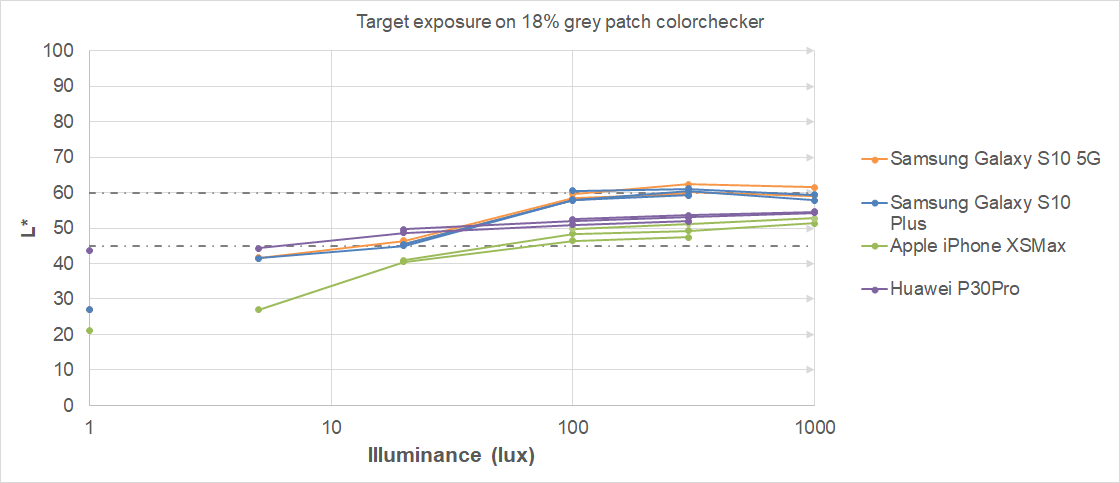
Samsung Galaxy S10 5G, target exposure analysis
The S10 5G deals very well with loftier-contrast scenes, such as the ane beneath. Target exposure is very good and the camera does well at preserving highlight and shadow details alike. As with the S10+, some highlight clipping occurs in scenes with extreme lighting contrasts. Merely also like the S10+, the S10 5G does very well with backlit scenes.

Samsung Galaxy S10 5G, loftier-contrast scene

Samsung Milky way S10 5G, crop
Indoors in low light, the S10 5G does a expert task of reducing motion artifacts. It as well does a slightly improve job of dealing with backlight than the iPhone XS Max, but not quite every bit good as the P30 Pro, which provides the all-time exposure of the subject:

Samsung Galaxy S10 5G, backlit portrait

Huawei P30 Pro, backlit portrait

Apple tree iPhone XS Max, backlit portrait

Color
Samsung Galaxy S10 5G (Exynos)
89
Color rendering is one area in which the S10 5G beats out the Huawei P30 Pro. In this outdoor scene, for example, you can see that it renders neutral and accurate colors, while the P30 Pro image has a slight cyan tint to the sky, some greenish in the building, and less brilliant flowers.

Samsung Galaxy S10 5G, outdoor color

Huawei P30 Pro, outdoor color

Xiaomi Mi 9, outdoor color
Indoors, the S10 5G provides rich, pleasing colour rendering, as shown in this office interior shot below:

Samsung Milky way S10 5G, indoor color

Huawei P30 Pro, indoor color

Apple iPhone XS Max, indoor color

Autofocus
Samsung Galaxy S10 5G (Exynos)
99
The Samsung Galaxy S10 5G scores very well in the Autofocus category, thanks to consistently accurate results in all light conditions. Below are the results from our xx lux long and curt delay tests. While the S10 5G doesn't characteristic a negative shutter lag similar the Huawei and Apple flagships, it is very quick and very consistent:
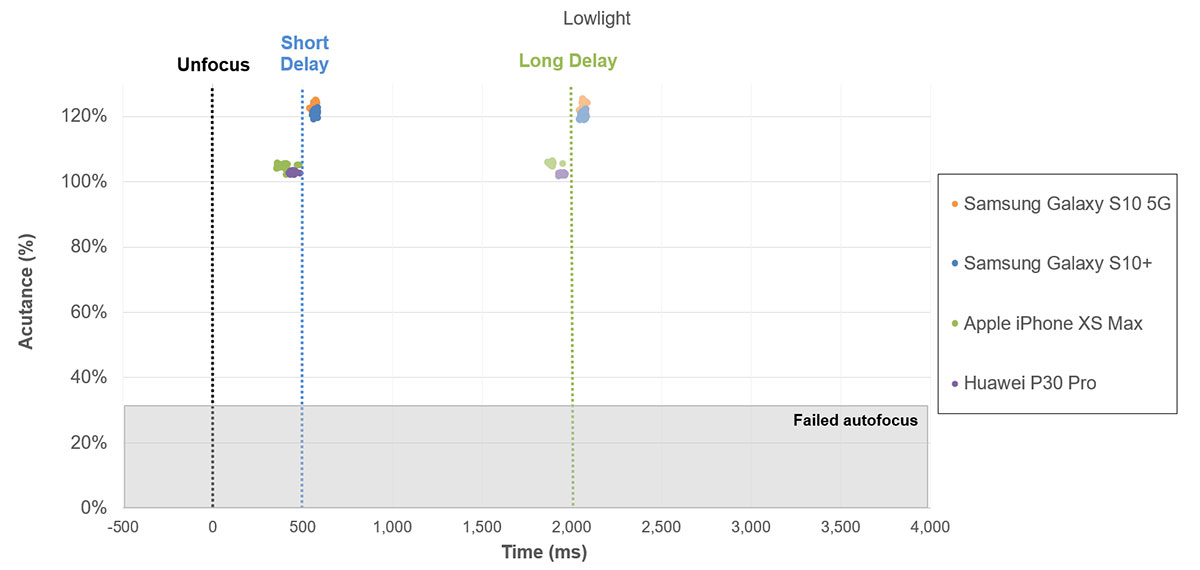
Autofocus performance comparing

Texture
Samsung Milky way S10 5G (Exynos)
71

Noise
Samsung Galaxy S10 5G (Exynos)
75
Like the S10+, the S10 5G does an splendid job of controlling racket in all lighting conditions, but the noise reduction tin result in a loss of textured item indoors and in depression low-cal, particularly when compared to the P30 Pro, as shown past a close look at the cloth strips in our lab exam scene.

Samsung S10 5G, hand-held at at 5 lux


Huawei P30 Pro, hand-held at at 5 lux

You can besides see this in the charted results from our Texture lab tests, shooting hand-held nether a range of lighting atmospheric condition:
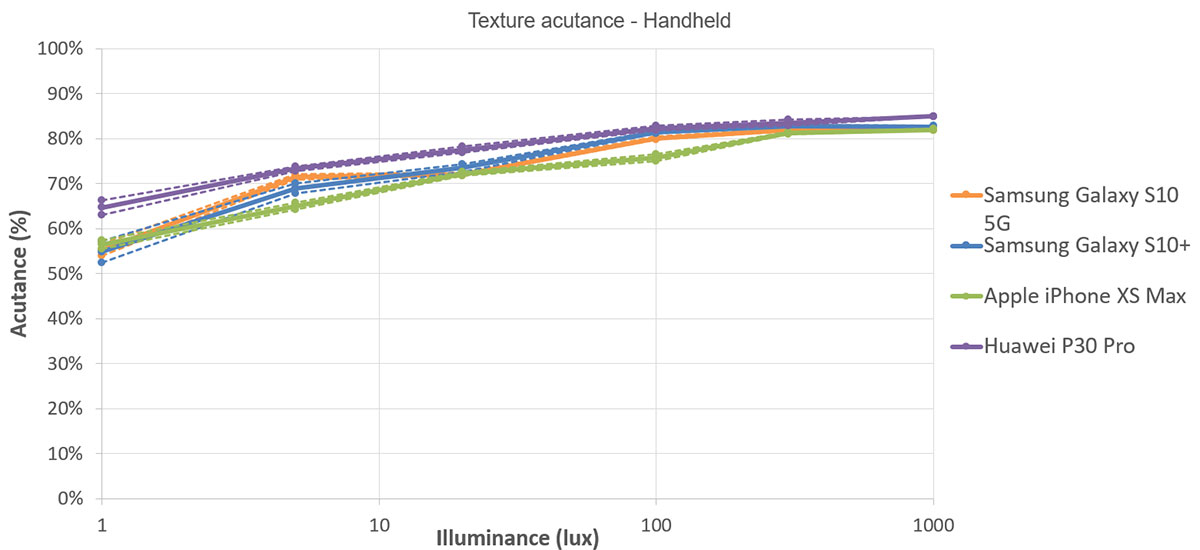
Texture acutance comparing
A difference in texture rendition is also visible in the brilliant-low-cal shot below, where the Huawei P30 Pro is capable of squeezing a piffling more fine detail out of the scene than the Samsung. On the plus side, the S10 5G controls noise well in near conditions, though some luminance dissonance is just well-nigh noticeable in this sample.

Samsung S10 5G. texture in brilliant light


Huawei P30 Pro, texture in bright light

In the graph below, y'all can run across that the 5G reduces noise more than the iPhone XS Max, simply even so trails the P30 Pro across almost all light levels.


Artifacts
Samsung Milky way S10 5G (Exynos)
78
While the S10 5G avoids most artifact issues, it does suffer from a couple that are worth noting. In particular, ringing is visible in detailed areas of images. There is also an issue caused by the lens, where corners of images can exist blurry, even though the center is precipitous. Y'all can run into both of these artifacts in this outdoor case, with ringing visible in the edifice detail and blurring in the grass at the edges of the image:

Samsung Galaxy S10 5G, ringing and corner softness

Samsung Galaxy S10 5G, ingather
The Galaxy S10 5G improves on the already excellent flash performance of the S10+. Like the S10+, flash photography with the S10 5G features accurate exposures, neutral white balance, and expert detail preservation. Samsung has lessened the lite falloff compared to the S10+, providing more pleasing images both when using only wink and when combining flash with ambience light. However, red-heart artifacts can be visible.

Zoom
Samsung Galaxy S10 5G (Exynos)
74
The S10 5G performs very much like its sibling S10+ when capturing default-way telephoto images, although at that place are fewer focus errors with the S10 5G. And while the S10+ sometimes switches which photographic camera information technology uses from frame to frame, the S10 5G consistently uses the same camera in a series of images taken at a consequent zoom level, resulting in improved resolution results overall.
Compared to the S10 5G, the Xiaomi Mi 9 sometimes produces better-resolution telephoto images, merely doesn't do as good a job at dissonance reduction and preventing artifacts. The S10 5G actually beats out the impressive zoom capability of the Huawei P30 Pro at a low zoom level, but information technology can't quite go on upwardly with the 5x folded optics at college levels of zooming. You tin see this for yourself in these comparison images:

Bokeh
Samsung Galaxy S10 5G (Exynos)
lxx
The S10 5G camera is capable of capturing very nice images in Portrait mode, simulating the bokeh created by the shallow depth of field of a DSLR + fast lens well plenty to earn itself one of the all-time scores in this category. In addition to smoothly blending the blur outcome as you motion from nigh to far in a scene, it has improved on the quality of the S10+ by rendering spotlights quite naturally.
Ane disadvantage of the S10+ when nosotros tested information technology is that it uses its 26mm primary lens every bit the principal lens when capturing Portrait-fashion images, which can cause some unflattering perspective distortion of the portrait subject area. Samsung has addressed that issue promptly in the S10 5G, assuasive users to switch to the longer telephoto lens in Portrait style. You can encounter the more natural proportions of the subject in the S10 5G version of the comparison images below, when compared to the S10+.

Samsung S10 5G, bokeh epitome

Samsung S10+, bokeh prototype

iPhone XS Max, bokeh image
Video scores explained
At 100 points, the Samsung Milky way S10 5G achieves our highest-always score for Video, making it an excellent choice for mobile videographers. The overall video score is derived from a number of sub-scores in the same style as the Photograph score: Exposure (86), Color (ninety), Autofocus (96), Texture (70), Dissonance (79), Artifacts (86), and Stabilization (93).
Overall, video from the S10 5G features the same excellent target exposure and color as on the S10+, and it makes an excellent trade-off between item preservation and noise reduction even when shooting hand-held in low calorie-free. The biggest upgrade in its video quality from the S10+ is increased detail thanks to shooting in 4K resolution by default. When viewing the sample clips below at total size, you tin can see that the S10 5G is capable of recording very loftier levels of detail in bright lite, capturing even slightly better fine item than the Xiaomi Mi ix, which also records 4K footage by default. Compared to the Huawei P30 Pro, which records 1080p footage by default, the divergence is even more noticeable.
Samsung Galaxy S10 5G, panning video in bright light
Huawei P30 Pro, panning video in bright light
Xiaomi Mi ix, panning video in bright low-cal
When shooting in low light and in typical indoor conditions, noise reduction is quite strong, however, resulting in a noticeable loss of detail. That said, compared to the Xiaomi Mi 9, the S10 5G does a better job of making the merchandise-off between item preservation and noise reduction when shooting mitt-held. Even though both devices shoot in 4K, you tin see more than detail with less noise in the S10 5G version than in the Mi 9 version of our low-light test videos below. Racket is peculiarly visible on the moving elements in the Xiaomi Mi 9 video.
Samsung Milky way S10 5G, mitt-held video at five lux
Huawei P30 Pro, hand-held video at five lux
Xiaomi Mi ix, hand-held video at 5 lux
The tables are turned when mounting the devices on a tripod and shooting in depression light, however, and the Samsung doesn't exercise as well every bit some competitors, every bit you tin see in the nautical chart beneath. In practiced low-cal, both the S10 5G and S10+ do an fantabulous task of preserving texture compared to the Mi nine and P30 Pro. Even so, as lite levels decrease, the Xiaomi and the Huawei capture improve video detail.

Texture comparison for tripod-mounted shooting across light levels.
Yous can run into the impact of this low-light upshot by looking at these crops from a frame taken from videos shot with the S10 5G and the Xiaomi Mi 9:

Samsung Galaxy S10 5G, depression light video on tripod (crop)

Xiaomi Mi nine, depression light video on tripod (crop)
Dynamic range is splendid for a traditional sensor and video recording organisation, merely not quite equally good as the Apple iPhone XS Max or other devices equipped with HDR sensor technology.

The Galaxy S10 5G features excellent video exposure even down to fairly low calorie-free levels.
The Samsung Milky way S10 5G also records video with accurate white residual and generally pleasing color in about weather condition. Autofocus is too excellent, and the S10 5G has very good video stabilization for hand-held videos.
Conclusion: First smartphone photographic camera to score 100 for video
Overall, the Milky way S10 5G performs slightly amend than the excellent S10+ in our tests. Samsung's move to 4K default resolution for video, and a benign switch to using the telephoto photographic camera for bokeh effects in portrait mode, requite the 5G version a 3-signal score crash-land to put it at the very top of all our tested mobile devices. The S10 5G as well gets to merits the title of being the first smartphone to score 100 points for video. Buyers of the 5G version of the S10 may be primarily interested in its next-generation connectivity, merely will get improvements to photos and videos as an additional benefit.
As with other devices with a similar camera setup, the S10 5G's ultra-broad-angle camera did not accept an touch on on its DxOMark score. However, an ultra-wide lens is a very useful tool for many, especially mural photographers and anyone hoping to capture images of large groups of people. Similarly, the added TOF sensor in the 5G version of the S10 doesn't touch on its score, just does allow for meliorate bokeh effects when desired in videos, and should better functioning for depth-sensitive augmented reality applications (for case). It will as well be interesting to meet if Samsung is able to provide the upgraded bokeh quality to S10+ owners via firmware update, since both models apply cameras with the same listed specifications.
Photo pros
- Accurate white residuum and pleasant colour rendering in most conditions.
- Accurate target exposure and good dynamic range.
- Fast, accurate, and repeatable autofocus.
- Pleasant bokeh effect with a good blur gradient and a nice shape.
- Well-controlled noise levels.
- Wink images with accurate target exposure, neutral white balance, and good item preservation.
Video pros
- Excellent detail in both outdoor and indoor weather condition.
- Accurate white balance and pleasant color rendering.
- Accurate exposure in both outdoor and indoor conditions.
- Fast and authentic autofocus.
- Efficient stabilization in hand-held videos.
- 4K recording at default settings.
Photograph cons
- Some visible artifacts including ringing, loss of sharpness at image edges, moiré, and ghosting
- Loss of fine and low contrast particular in near tested weather.
- Some subject area isolation artifacts in bokeh mode.
- Loss of detail when zooming, specially at long range.
Video cons
- Highlight clipping in high-dissimilarity scenes.
- Some slight exposure instabilities, especially indoors in depression calorie-free.
- Loss of detail in low light.
- Instability caused by lens breathing during autofocus convergence.
In the Press
Source: https://www.dxomark.com/samsung-galaxy-s10-5g-camera-review/
Posted by: jarvisthele1947.blogspot.com

0 Response to "How To Switch Cameras On Galaxy S10"
Post a Comment